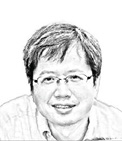Art museum back and better than ever
AFTER three years of construction work, the Liu Haisu Art Museum in Chang-ning District has reopened for trial operations at its new, expanded location along Yan’an Road W., not far from Zhongshan Park.
The first exhibition will feature seven young artists, an event in cooperation with Tencent, one of China’s biggest online service operators, according to the museum’s director Zhu Gang.
The museum has reached a strategic cooperation with Tencent.
There are about 960,000 artists and designers who have registered on Tencent. The company offers some online exposure for them, but the museum will provide an off-line platform for their work.
Outside the museum there is a 300-meter “graffiti wall,” created by students from the Fine Arts College at Shanghai University — they copied ideas they saw on the Internet after obtaining the original artists’ permission.
The original artists’ names will be written next to the art. The wall will change annually as part of the museum’s exhibition of artwork from the Internet.
Named after Liu Haisu (1896-1994), a founder of the China New Art Movement, the museum first opened in 1995.
Liu, a prominent painter and noted art educator, played a vital role in the Chinese fine-art world for nearly seven decades.
From a young age, he showed a fondness for painting, and at 14 he moved to Shanghai to receive art training. When he was just 17, he and his friends established their own fine-art school, the Shanghai Institute of Fine Art, one of the first organizations of its kind in modern China.
Liu was also one of the most widely-traveled Chinese artists of his day.
During trips to Europe he became personally acquainted with several of the early 20th-century’s leading artists, including Picasso, whom he met in Paris in 1929.
Liu’s own works were remarkable for their blending of traditional Chinese painting techniques with European fine-art movements, including Impressionism and its associated schools. He promoted this mixed style as a model for revolutionizing art education in China.
Originally built as a museum/memorial hall, the Liu Haisu Art Museum contains works by Liu as well as painting and calligraphy pieces from other Chinese art masters.
Some of these latter pieces are considered national treasures, such as the scroll work “Peacocks Perching on Rocks” by Badashanren (1626-1705) and Li Zao’s “A Military Review,” which dates to the Jin Dynasty (265-420 AD).
Today, the museum’s new venue includes 12,000 square-meters of floor space spreading over six exhibition halls.
- About Us
- |
- Terms of Use
- |
-
 RSS
RSS - |
- Privacy Policy
- |
- Contact Us
- |
- Shanghai Call Center: 962288
- |
- Tip-off hotline: 52920043
- µ▓¬ICPĶ»ü’╝ܵ▓¬ICPÕżć05050403ÕÅĘ-1
- |
- õ║ÆĶüöńĮæµ¢░ķŚ╗õ┐Īµü»µ£ŹÕŖĪĶ«ĖÕÅ»Ķ»ü’╝Ü31120180004
- |
- ńĮæń╗£Ķ¦åÕɼĶ«ĖÕÅ»Ķ»ü’╝Ü0909346
- |
- Õ╣┐µÆŁńöĄĶ¦åĶŖéńø«ÕłČõĮ£Ķ«ĖÕÅ»Ķ»ü’╝ܵ▓¬ÕŁŚń¼¼354ÕÅĘ
- |
- Õó×ÕĆ╝ńöĄõ┐ĪõĖÜÕŖĪń╗ÅĶÉźĶ«ĖÕÅ»Ķ»ü’╝ܵ▓¬B2-20120012
Copyright ┬® 1999- Shanghai Daily. All rights reserved.Preferably viewed with Internet Explorer 8 or newer browsers.


